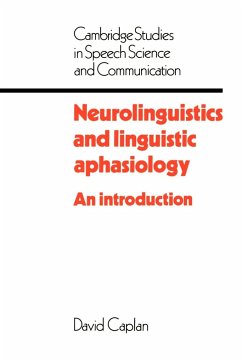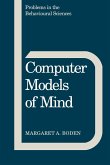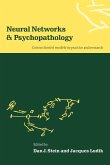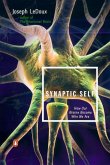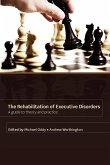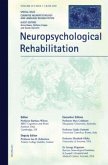- Broschiertes Buch
- Merkliste
- Auf die Merkliste
- Bewerten Bewerten
- Teilen
- Produkt teilen
- Produkterinnerung
- Produkterinnerung
This textbook provides the first up-to-date, comprehensive introduction to the emerging fields of neurolinguistics and linguistic aphasiology.
Andere Kunden interessierten sich auch für
![Computer Models of Mind Computer Models of Mind]() Margaret A. BodenComputer Models of Mind69,99 €
Margaret A. BodenComputer Models of Mind69,99 €![Human Organic Memory Disorders Human Organic Memory Disorders]() Andrew R. MayesHuman Organic Memory Disorders83,99 €
Andrew R. MayesHuman Organic Memory Disorders83,99 €![Neural Networks and Psychopathology Neural Networks and Psychopathology]() Dan J. M. D. SteinNeural Networks and Psychopathology85,99 €
Dan J. M. D. SteinNeural Networks and Psychopathology85,99 €![Synaptic Self Synaptic Self]() Joseph LedouxSynaptic Self15,99 €
Joseph LedouxSynaptic Self15,99 €![NLP NLP]() D Burns AlanNLP21,99 €
D Burns AlanNLP21,99 €![Rehabilitation of Executive Disorders Rehabilitation of Executive Disorders]() Micahel OddyRehabilitation of Executive Disorders113,99 €
Micahel OddyRehabilitation of Executive Disorders113,99 €![Cognitive Neuropsychology and Language Rehabilitation Cognitive Neuropsychology and Language Rehabilitation]() Anna Basso / Stefano Cappa / Guido Gainotti (eds.)Cognitive Neuropsychology and Language Rehabilitation53,99 €
Anna Basso / Stefano Cappa / Guido Gainotti (eds.)Cognitive Neuropsychology and Language Rehabilitation53,99 €-
-
-
This textbook provides the first up-to-date, comprehensive introduction to the emerging fields of neurolinguistics and linguistic aphasiology.
Produktdetails
- Produktdetails
- Verlag: Cambridge University Press
- Seitenzahl: 512
- Erscheinungstermin: 13. Januar 2002
- Englisch
- Abmessung: 229mm x 152mm x 30mm
- Gewicht: 823g
- ISBN-13: 9780521311953
- ISBN-10: 0521311950
- Artikelnr.: 22012364
- Herstellerkennzeichnung
- Libri GmbH
- Europaallee 1
- 36244 Bad Hersfeld
- gpsr@libri.de
- Verlag: Cambridge University Press
- Seitenzahl: 512
- Erscheinungstermin: 13. Januar 2002
- Englisch
- Abmessung: 229mm x 152mm x 30mm
- Gewicht: 823g
- ISBN-13: 9780521311953
- ISBN-10: 0521311950
- Artikelnr.: 22012364
- Herstellerkennzeichnung
- Libri GmbH
- Europaallee 1
- 36244 Bad Hersfeld
- gpsr@libri.de
Preface
Part I. Introduction: 1. Issues in neurolinguistics and linguistic aphasiology
2. Approaches to neuolinguistics and linguistics aphasiology
Part II. Clinical Aphasiology and Neurolinguistics: 3. The discoveries of Paul Broca: localization of the 'faculty for articulate language'
4. Classical connectionist models
5. Extensions of connectionism
6. Objections to connectionism
7. Hierarchical models
8. Global models
9. Process models
10. Overview of clinical aphasiology and neurolinguistics
Part III. Linguistic Aphasiology: 11. Linguistic descriptions and aphasic syndromes
12. Disturbances of lexical semantic representation
13. Disturbances of the sound system
14. Acquired dyslexia
15. Disturbances of sentence production: agrammatism
16. Disturbances of sentence comprehension
17. Overview of linguistic aphasiology
Part IV. Contemporary Neurolinguistics: 18. Cerebral dominance and specialization for language
19. Cerebral localization for language revisited
20. Cerebral evoked potentials and language
21. Electrical stimulation of the language areas
22. Towards a theoretical neurophysiology of language
23. Overview of contemporary neurolinguistics
References
Author index
Subject index.
Part I. Introduction: 1. Issues in neurolinguistics and linguistic aphasiology
2. Approaches to neuolinguistics and linguistics aphasiology
Part II. Clinical Aphasiology and Neurolinguistics: 3. The discoveries of Paul Broca: localization of the 'faculty for articulate language'
4. Classical connectionist models
5. Extensions of connectionism
6. Objections to connectionism
7. Hierarchical models
8. Global models
9. Process models
10. Overview of clinical aphasiology and neurolinguistics
Part III. Linguistic Aphasiology: 11. Linguistic descriptions and aphasic syndromes
12. Disturbances of lexical semantic representation
13. Disturbances of the sound system
14. Acquired dyslexia
15. Disturbances of sentence production: agrammatism
16. Disturbances of sentence comprehension
17. Overview of linguistic aphasiology
Part IV. Contemporary Neurolinguistics: 18. Cerebral dominance and specialization for language
19. Cerebral localization for language revisited
20. Cerebral evoked potentials and language
21. Electrical stimulation of the language areas
22. Towards a theoretical neurophysiology of language
23. Overview of contemporary neurolinguistics
References
Author index
Subject index.
Preface
Part I. Introduction: 1. Issues in neurolinguistics and linguistic aphasiology
2. Approaches to neuolinguistics and linguistics aphasiology
Part II. Clinical Aphasiology and Neurolinguistics: 3. The discoveries of Paul Broca: localization of the 'faculty for articulate language'
4. Classical connectionist models
5. Extensions of connectionism
6. Objections to connectionism
7. Hierarchical models
8. Global models
9. Process models
10. Overview of clinical aphasiology and neurolinguistics
Part III. Linguistic Aphasiology: 11. Linguistic descriptions and aphasic syndromes
12. Disturbances of lexical semantic representation
13. Disturbances of the sound system
14. Acquired dyslexia
15. Disturbances of sentence production: agrammatism
16. Disturbances of sentence comprehension
17. Overview of linguistic aphasiology
Part IV. Contemporary Neurolinguistics: 18. Cerebral dominance and specialization for language
19. Cerebral localization for language revisited
20. Cerebral evoked potentials and language
21. Electrical stimulation of the language areas
22. Towards a theoretical neurophysiology of language
23. Overview of contemporary neurolinguistics
References
Author index
Subject index.
Part I. Introduction: 1. Issues in neurolinguistics and linguistic aphasiology
2. Approaches to neuolinguistics and linguistics aphasiology
Part II. Clinical Aphasiology and Neurolinguistics: 3. The discoveries of Paul Broca: localization of the 'faculty for articulate language'
4. Classical connectionist models
5. Extensions of connectionism
6. Objections to connectionism
7. Hierarchical models
8. Global models
9. Process models
10. Overview of clinical aphasiology and neurolinguistics
Part III. Linguistic Aphasiology: 11. Linguistic descriptions and aphasic syndromes
12. Disturbances of lexical semantic representation
13. Disturbances of the sound system
14. Acquired dyslexia
15. Disturbances of sentence production: agrammatism
16. Disturbances of sentence comprehension
17. Overview of linguistic aphasiology
Part IV. Contemporary Neurolinguistics: 18. Cerebral dominance and specialization for language
19. Cerebral localization for language revisited
20. Cerebral evoked potentials and language
21. Electrical stimulation of the language areas
22. Towards a theoretical neurophysiology of language
23. Overview of contemporary neurolinguistics
References
Author index
Subject index.

